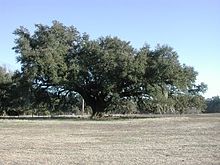Evergreen

In botany, an evergreen is a plant which has foliage that remains green and functional throughout the year. This contrasts with deciduous plants, which lose their foliage completely during the winter or dry season.
Evergreen species
This section needs additional citations for verification. (December 2022) |
There are many different kinds of evergreen plants, both trees and shrubs. Evergreens include:
- Most species of conifers (e.g., pine, hemlock, spruce, and fir), but not all (e.g., larch).
- Live oak, holly, and "ancient" gymnosperms such as cycads
- Many woody plantsfrom frost-free climates
- Rainforest trees
- All eucalypts
- Clubmosses and relatives
- Most bamboos
The Latin binomial term sempervirens, meaning "always green", refers to the evergreen nature of the plant, for instance:
- Cupressus sempervirens (a cypress)
- Lonicera sempervirens (a honeysuckle)
- Sequoia sempervirens (a sequoia)
The longevity of individual leaves in evergreen plants varies from a few months to several decades (over 30 years in the Great Basin bristlecone pine[1]).
Evergreen families
| Family name | Example |
|---|---|
| Araucariaceae | Kauri |
| Cupressaceae | Sequoia |
| Pinaceae | Pine |
| Podocarpaceae | Real yellowwood |
| Taxaceae | Yew |
| Cyatheaceae | Australian tree fern
|
Aquifoliaceae |
Holly |
| Fagaceae | Live oak |
| Oleaceae | Shamel ash |
| Myrtaceae | Eucalyptus |
| Arecaceae | Coconut |
| Lauraceae | Bay |
| Magnoliaceae | Southern magnolia |
Cycadaceae |
Queen sago |
Japanese umbrella pine is unique in that it has its own family of which it is the only species.
Differences between evergreen and deciduous species
Evergreen and deciduous species vary in a range of morphological and physiological characters. Generally, broad-leaved evergreen species have thicker leaves than deciduous species, with a larger volume of parenchyma and air spaces per unit leaf area.[2] They have larger leaf biomass per unit leaf area, and hence a lower specific leaf area. Construction costs do not differ between the groups.[citation needed] Evergreens have generally a larger fraction of total plant biomass present as leaves (LMF),[3] but they often have a lower rate of photosynthesis.
Reasons for being evergreen or deciduous
This section needs additional citations for verification. (August 2023) |

Deciduous trees shed their leaves usually as an adaptation to a cold or dry/wet season. Evergreen trees also lose leaves, but each tree loses its leaves gradually and not all at once. Most
In areas where there is a reason for being deciduous, e.g. a cold season or dry season, evergreen plants are usually an adaptation of low nutrient levels. Additionally, they usually have
In temperate climates, evergreens can reinforce their own survival; evergreen leaf and needle litter has a higher carbon-nitrogen ratio than deciduous
See also
- Semi-deciduous (semi-evergreen)
References
- ^ Ewers, F. W. & Schmid, R. (1981). "Longevity of needle fascicles of Pinus longaeva (Bristlecone Pine) and other North American pines". Oecologia 51: 107–115
- PMID 24107583.
- PMID 26197869.
- ^ from the original on 2022-09-13. Retrieved 2021-02-16.
- PMID 25817313.
- ^ Aerts, R. (1995). "The advantages of being evergreen" Archived 2015-09-24 at the Wayback Machine. Trends in Ecology & Evolution 10 (10): 402–407.
- ^ Matyssek, R. (1986) "Carbon, water and nitrogen relations in evergreen and deciduous conifers". Tree Physiology 2: 177–187.
- ^ Sobrado, M. A. (1991) "Cost-Benefit Relationships in Deciduous and Evergreen Leaves of Tropical Dry Forest Species". Functional Ecology 5 (5): 608–616.
External links
- Helen Ingersoll (1920). . Encyclopedia Americana.
